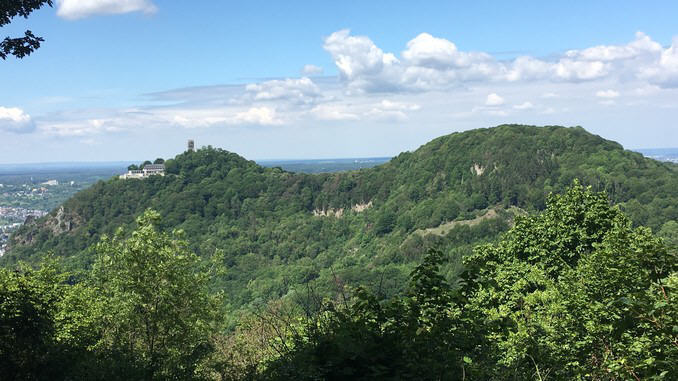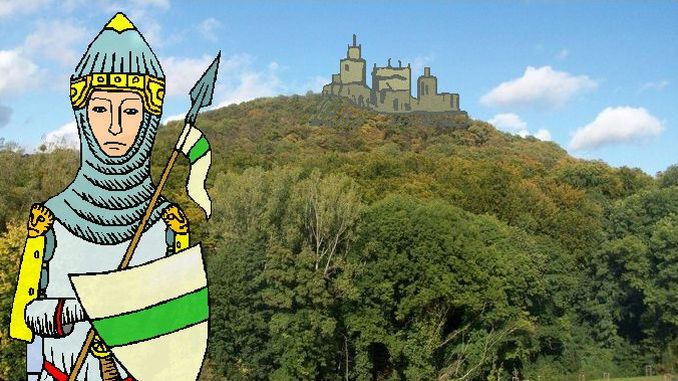
The mountains Drachenfels and Wolkenburg, connected by a lower-lying mountain ridge, characterize the image of the Siebengebirge.
It is said that Mount Wolkenburg (“Castle of the Clouds”) was once the highest mountain of all. But over centuries it was used as a quarry, and so its original shape got lost. The fine latite was perfect for the fronts of representative Baroque and Rococo buildings, so ambitious stonemasons asked for it. Today, the Wolkenburg is 324 meters high, that makes it a mere hill.
Wolkenburg Castle
Nothing has been remained of the medieval castle on top of Mount Wolkenburg either. And yet, in the Middle Ages the castle with the Archbishop’s “Authority of Wolkenburg” must have been one of the most powerful on the Rhine river. Today we have only a sketch of how it may have looked like.

At the time of the Salian dynasty, the archbishops of Cologne were powerful men in the Holy Roman Empire and in our region. Archbishop Friedrich I of Schwarzenburg (1100-1131) secured the south of the archbishopric by building several fortifications, among them Castle Wolkenburg in 1118 and Castle Rolandseck on the other side of the Rhine. On the eve of the second crusade in 1146, when once again the Jews were persecuted, he offered the Jews of Cologne shelter at Wolkenburg Castle. The archbishop himself liked to come here, and he also died at Wolkenburg Castle.
Counts of Wolkenburg
Only little is known about the burgraves on Wolkenburg Castle. As a liegeman of the Archbishop of Cologne, Ludwig von Wolkenburg followed him into the Battle of Worringen in 1288, together with the Burgraves of Drachenfels and Johann I von Löwenberg. They were defeated and the burgraves were taken prisoner by the Count of Berg. For a considerable time, he was an involuntary liegeman to Berg.
In the middle of the 14th century, the Counts of Wolkenburg died out.
The Wolkenburg is pledged
In the late Middle Ages, at the time of the Luxembourg dynasty, Burgrave Godart vom Drachenfels was a rich and powerful man in our region. A “trachyte tycoon” one might say, because the trachyte mined from Mount Drachenfels for the Cologne Cathedral had made him rich. The Archbishop of Cologne, Dietrich von Moers, had repeatedly asked him for money. In 1425, he was so deeply in debt to Burgrave Godart that he had to pledge Castle Wolkenburg to him.
Little is known about the further history of the castle. In the 16th Century the castle was abandoned and fell apart. Shortly before the outbreak of the Thirty Years’ War (1618-1648), it was already left to decay.
Today we have no more castle ruin, but we have wonderful hiking trails around the Wolkenburg. Enjoy!
 German names
German names
Wolkenburg
Feminine in German, Cloud castle, or better: castle so high that it touches the clouds. As we have seen above, the Wolkenburg once was the highest mountain in the Siebengebirge, so it might have touched the clouds.

Be the first to comment